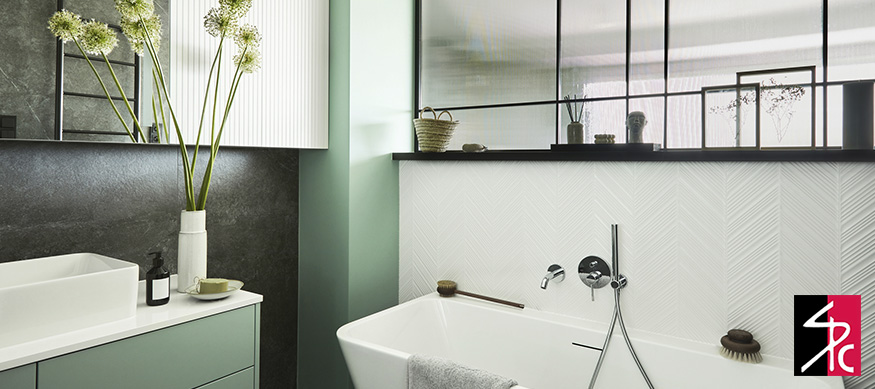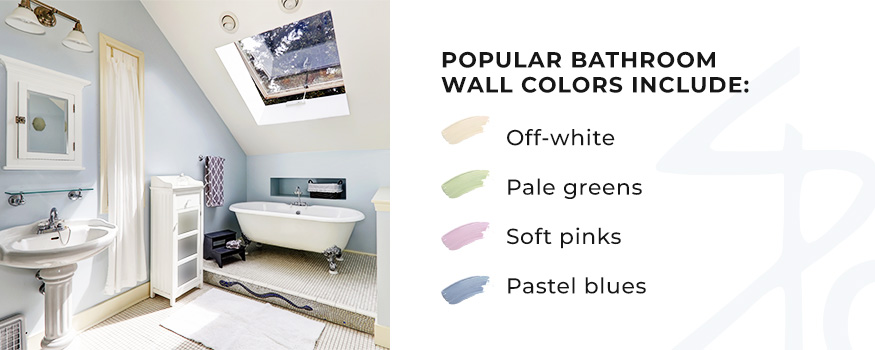A Guide to Painting Your Bathroom
October 10, 2024

Whether you are redesigning your entire bathroom or just want to give the room a fresh look, having your bathroom professionally painted can help you bring new life to the space. Professional painters can ensure your new paint job looks great while offering dependable performance.
Bathrooms are high-traffic areas that experience significant moisture. You need paint that can meet the demands of this environment. Read on for bathroom painting advice that can help you prepare for a successful paint job.
Choosing the Best Paint for Your Bathroom
The bathroom is a unique room within a home — it deserves special attention to ensure it is the relaxing retreat and functional space you need it to be. Selecting the right paint will help you create an attractive bathroom that can withstand the moisture, humidity and high traffic it receives.
Consider these factors when choosing paint for your bathroom.
1. Durability
Your bathroom paint and primer should hold up well in a warm, humid environment. High-quality options will effectively repel moisture and mildew, keeping your bathroom clean and healthy for years to come. High-gloss or semi-gloss paints are best for resisting moisture, and they are easy to wipe clean.
2. Color
When deciding on paint for your bathroom, you can tape color swatches to the wall. Bringing different colors into the space will help you see and compare how they react with the light available in the room.
Your bathroom should feel luxurious, relaxing and clean. The paint colors you choose for the walls will significantly affect the room’s ambience, so go for lighter colors that can brighten the space, keep it airy and make it feel larger. If your bathroom walls have imperfections, try using a neutral color to hide the rough spots while still making your bathroom feel lighter.
Popular bathroom wall colors include:
- Off-white.
- Pale greens.
- Soft pinks.
- Pastel blues.
If you also want to paint the ceiling, choose the same paint color as the walls. This uniformity gives the impression of more airiness and greater space, regardless of your bathroom’s actual size.
3. Finish
Choosing the right sheen is just as important as selecting the right color. The higher the sheen, the more durable and easier to clean the paint will be. A satin finish paint can be ideal for bathroom walls with imperfections, offering durability while not attracting attention to imperfections.
How to Prep Your Bathroom Walls for Painting
Preparation is key to a successful paint job. Cleaning and preparing the space promotes long-lasting results. It also ensures your property remains safe and clean throughout the painting process.
Follow these steps to prepare your bathroom walls for your upcoming paint job.
1. Clean the Walls
Common bathroom contaminants, such as mold, mildew, hair, soap scum and general grime, can make it difficult for new paint to stick to your bathroom walls. Thoroughly cleaning your walls before painting ensures your new coat of paint sticks and doesn’t peel off later on.
A household mixture of three parts water and one part bleach is an effective cleaning solution for bathroom walls. It can help you quickly remove mildew and any other type of buildup, ensuring your painters have a fresh, clean surface to work with. After scrubbing the walls with the bleach mixture, use a clean rag to wipe them down. Give your walls enough time to dry completely before proceeding with the next steps of your painting project.
2. Prepare the Workspace
Before your painters arrive, remove everything you can from the bathroom, including rugs, soap bottles, towels and decorations. Taking out other potential obstructions, such as mirrors, outlet plates, exhaust vent grilles and towel racks, will give your painters the space they need to paint the room quickly and effectively.
Tape off the borders around the room, including the ceiling, doors and vanity cabinets. Laying a drop cloth on the floor will protect your flooring material and minimize messes from paint splatters. Be sure to cover anything you want to avoid painting, including sinks and the toilet. To paint behind a toilet tank, you may need to remove the tank so the painters will have enough room to paint the area properly.
When our professionals arrive at your home, they can help with these tasks to prepare the room and ensure everything is ready for a seamless painting process.
The Process for Painting Walls in Bathrooms
Painting bathroom walls is much like painting any other interior surface in a house. At Shoreline Painting, our painters follow a simple yet effective process to ensure your satisfaction.
1. Outline the Borders
Our painters use a paintbrush to paint a wide 3- to 4-inch margin around the borders of your project area. The paintbrush allows for more control in tighter spaces along wall-to-ceiling borders, doorframes, baseboards, cabinets and other border areas that require precision.
2. Paint the Center of the Wall
After painting along the room’s borders, our painters will switch to a paint roller to cover the walls. Light strokes with even pressure ensure a thin and smooth paint coat. Our painters start in the middle of the wall, using upward and downward strokes to spread the paint evenly over the large area.
3. Connect the Center and Border
The roller will have less paint on it after covering the center of the wall. At this point, our painters can use the roller to paint the areas closer to the borders, connecting with the paintbrush job without causing thick and uneven paint buildup.
4. Let the Paint Dry and Apply More Coats
Our professional team will paint an initial coat throughout the room and give it time to dry. Paint drying times will depend on the size of the room and humidity in the space. Once the paint is dry, our painters will continue to apply additional coatings to ensure an even finish.
5. Clean Up
After the final paint coat has dried, our painters will remove the painter’s tape and any coverings in the room. You can start replacing any items you removed, but it is best to wait about 24 hours before resuming regular bathroom use.
Revitalize Your Bathroom With Help From Shoreline Painting
Our expert painters can repaint your bathroom walls for a fresh, clean look that transforms the space. As a Fine Paints of Europe Master Certified Painter, we provide detailed attention to each project, ensuring precision throughout the process. Our highly skilled team knows how to paint a bathroom for beautiful, long-lasting results.
Contact us today to request a consultation and see what we can do for the bathroom in your Connecticut or New York home.
Recent Posts & Guides










